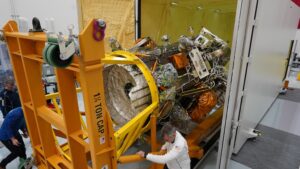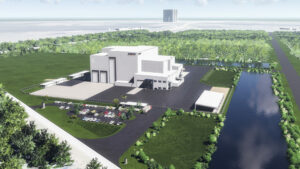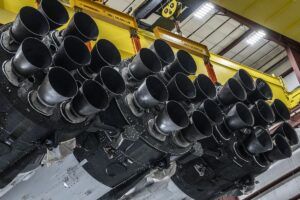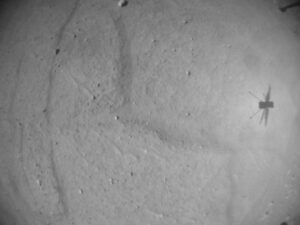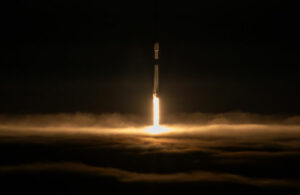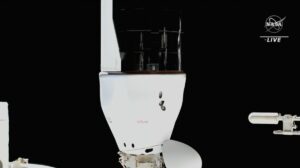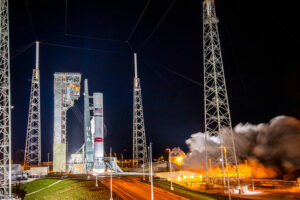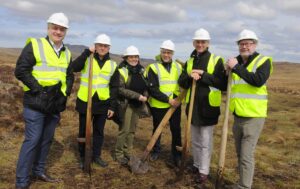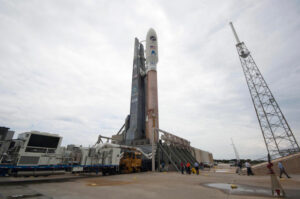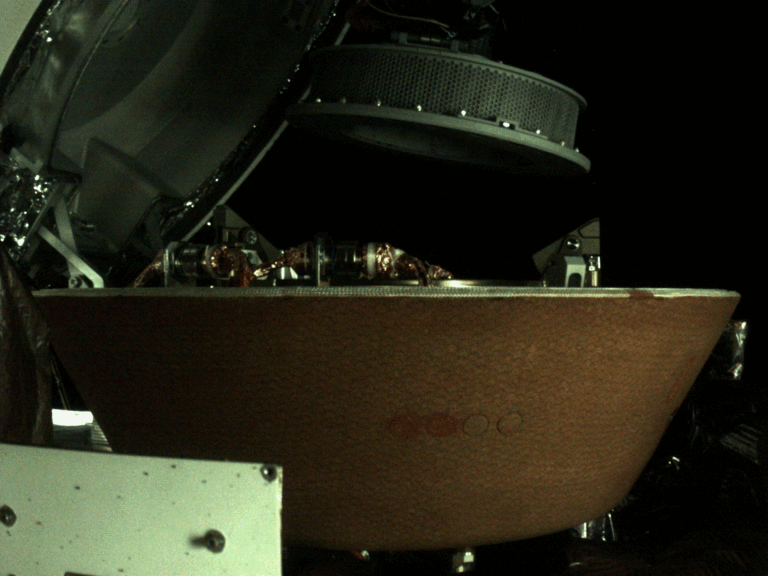
For the first time in its agency’s history, NASA is bringing home a sample of an asteroid. The nearly eight-ounce sample from carbon-rich asteroid Bennu is set to land in the desert of the Utah Test and Training Range (UTTR) on Sunday, Sept. 24.
The Origins, Spectral Interpretation, Resource Identification, and Security-Regolith Explorer (OSIRIS-REx) spacecraft launched back in Sept. 15, 2016 and collected a sample from Bennu on Oct. 20, 2020.
It began making its way back towards Earth over the last couple of years. After making it’s final trajectory maneuver on Sept. 17, OSIRIS-REx is just about ready to release its precious cargo.
Following sample release, the spacecraft will adjust its course and get renamed “OSIRIS-APEX” as it journeys off to observe another asteroid: 99942 Apophis.
Speaking with Spaceflight Now on the anniversary of the mission launch, Dante Lauretta, the OSIRIS-REx principal investigator, said he and his team are buzzing with excitement.
“We’re in major anticipation. The culmination of the seven-year adventure to asteroid Bennu and back is about to occur,” Lauretta said. “As amazing as the science was that we did at Bennu, this mission’s all about analyzing that return sample.”
Lauretta, who is also a professor of planetary science and cosmochemistry at the University of Arizona’s Lunar and Planetary Laboratory, is coordinating with a team of more than 200 researchers around the world who will be using more than 60 different analytical techniques to study the pristine specimen.
Lauretta said they were able to capture and contain an estimated 250 grams, or about an eight-ounce cup’s worth, of asteroid pieces when they made contact with the asteroid in the fall of 2020.
The primary tool used to capture the sample was the Touch-and-Go Sample Acquisition Mechanism (TAGSAM), which was built by Lockheed Martin.
“We probably had a lot more than that because we did lose material after sample collection, kind of a victim of our own success. We really filled the sample collector all the way to the brim,” Lauretta said. “I compare it to when you get a bucket of water and you fill it right to the lip and then you try and move it around. There’s going to be stuff splashing off all around you. That’s the situation that we were in.”
Nevertheless, Lauretta noted that capturing 250 grams is more than four times what they promised they would deliver with this sample collection.

Why collect an asteroid sample?
The chunk of Bennu that’s being brought back to Earth represents only the third time such a sample return has been done with the first two being led by Japan. They retrieved a sample from asteroid 25143 Itokawa in 2010 and from 162173 Ryugu in 2020.
Those missions were dubbed Hayabusa and Hayabusa2, Japanese for “peregrine falcon.”
Bennu is what scientists classify as a carbonaceous or “C-type” asteroid, which consist of clay and silicate rocks along with a large amount of carbon. They are also the most common type of asteroid in the solar system.
Dr. Beau Bierhaus, the TAGSAM lead scientist for Lockheed Martin told Spaceflight Now on Monday that collecting pristine samples of asteroids like Bennu, along with observation missions like Lucy, which launched in 2021 to explore the Trojan asteroids, are important tools in helping us better understand the origins of life here on Earth.
“These missions are incredibly profound because they are telling us about the complexity of the solar system, but they’re also telling us about how the more we learn about other planets, the more we’re learning about Earth and our place on Earth,” Bierhaus said.
[embedded content]
How will sample return work?
On Sunday morning at 2 a.m. Mountain Daylight Time, the various teams on the ground in Utah will have a final Go/No-Go poll to determine if they are ready to release the capsule with the asteroid sample inside.
In what leaders describe as an “unlikely” No-Go scenario, there would be another opportunity in a couple years to try again.
“We do have an opportunity to bring this return capsule back in September 2025,” said Sandy Freund, the OSIRIS- Rex program manager at Lockheed Martin, told Spaceflight Now on Monday. “So, a two-year delay, which is not ideal, but it is an option, should we need it.
If teams are good to go, a command will be sent to the spacecraft with a release of the capsule at 4:42 a.m. MDT. There at then four hours between release and entry.
Then the drogue parachute will be deployed, followed by the main parachute, which will slow the capsule down to about 10 miles per hour.
Before the capsule reaches the ground, sensors at the UTTR will be tracking the payload along with airborne NASA assets.
Once it’s on the ground, four helicopters will be used to begin the ground recovery. The first helicopter will include folks from the range to ensure that the capsule is safe to approach. That will be followed by a Lockheed Martin team who will examine the capsule and make sure it’s cool enough to touch. They will also start the preparations to bring the capsule to a temporary clean room in Utah.
As that is underway, a science team, led by Lauretta, will sample the area around the capsule to catalogue the local environment around the capsule.
“One of the key scientific objectives of OSIRIS-REx is to return a pristine sample and ‘pristine’ means that no foreign material hampers our investigation during sample analysis,” Lauretta said in a media teleconference on Friday.
“As unlikely as it is, we want to make sure that any materials that are out there in the Utah range that may interact with the sample are well documented,” he added.
In a most ideal timeline, the sample would then be dropped off at a temporary clean room sometime before 11 a.m. MDT and disassembly could begin as early as 11:30 a.m. MDT with completion before 5 p.m. MDT.
Disassembly involves removing the heat shield and back shell of the capsule to reveal the sample canister, which OSIRIS-REx Lead Curator Nicole Lunning describes as a “nesting doll” of sorts.
The canister will have a nitrogen flow put on it to create a protective, localized atmosphere. That container with the sample will be flown to Ellington Air Force Base in Houston before it’s finally driven to Johnson Space Center.
There it will be opened and scientific analysis will begin.
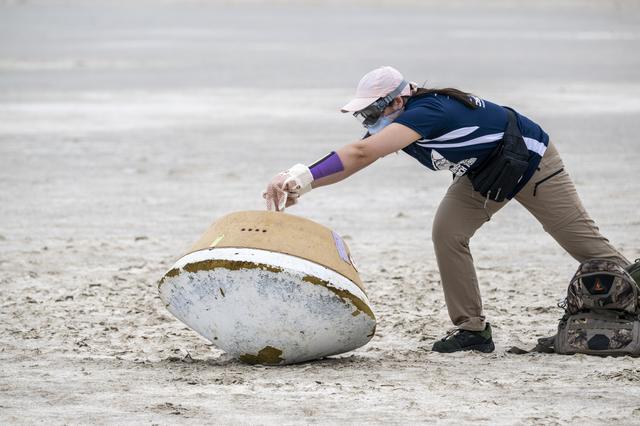
When will scientists begin studying the sample collected?
The earliest that the canister lid containing the sample will come off will be on Monday, Sept. 25, if everything goes ahead of schedule. A nominal scenario has the lid coming off on Tuesday, Sept. 26.
The unveiling won’t be live-streamed, but NASA officials said they would document and share the footage with the public. A news conference is planned for Oct. 11 to discuss initial analysis with comments from Lauretta along with NASA Administrator Bill Nelson; Francis McCubbin, OSIRIS-REx deputy curation lead; and Daniel Galvin, OSIRIS-REx sample analysis lead.
“Tag felt surreal, but in some way, the sample return itself is taking that surrealness to a whole other level. We’ve been working on this mission for over a decade and if you count the proposal phase, it’s getting on to close to two decades,” Bierhaus said. “So, to spend so long on something and to have it finally become real, it’s pretty extraordinary.”
- SEO Powered Content & PR Distribution. Get Amplified Today.
- PlatoData.Network Vertical Generative Ai. Empower Yourself. Access Here.
- PlatoAiStream. Web3 Intelligence. Knowledge Amplified. Access Here.
- PlatoESG. Carbon, CleanTech, Energy, Environment, Solar, Waste Management. Access Here.
- PlatoHealth. Biotech and Clinical Trials Intelligence. Access Here.
- Source: https://spaceflightnow.com/2023/09/22/nasa-is-bringing-an-asteroid-sample-back-to-earth-heres-when-how-and-why/
- :has
- :is
- :not
- ][p
- $UP
- 10
- 11
- 15%
- 17
- 20
- 200
- 2016
- 2020
- 2021
- 2023
- 2025
- 24
- 25
- 250
- 26
- 27
- 30
- 60
- a
- Able
- About
- acquisition
- added
- adjust
- Adventure
- After
- again
- against
- ahead
- AIR
- Air Force
- All
- along
- also
- amazing
- amount
- an
- analysis
- Analytical
- analyzing
- and
- Anniversary
- Another
- anticipation
- any
- approach
- ARE
- AREA
- ARM
- around
- AS
- Assets
- Asteroid
- asteroids
- At
- Atmosphere
- back
- base
- BE
- because
- become
- been
- before
- began
- begin
- being
- Better
- between
- Bill
- blow
- bring
- Bringing
- brought
- built
- but
- Buzzing
- by
- CAN
- capture
- captured
- Capturing
- carbon
- Cargo
- Center
- Classify
- Close
- collect
- Collecting
- collection
- collector
- come
- coming
- comments
- Common
- compare
- completion
- complexity
- Conference
- contact
- contain
- Container
- content
- Cool
- coordinating
- could
- Couple
- course
- create
- curation
- Daniel
- daylight
- decade
- decades
- delay
- deliver
- Department
- deployed
- deputy
- describe
- DESERT
- Determine
- DID
- different
- discuss
- do
- document
- documented
- done
- down
- driven
- dropped
- dubbed
- during
- Dust
- earliest
- Early
- earth
- embedded
- end
- enough
- ensure
- entry
- Environment
- estimated
- everything
- examine
- Excitement
- explore
- explorer
- extraordinary
- falcon
- Fall
- felt
- few
- field
- fill
- filled
- final
- Finally
- First
- first time
- five
- flow
- followed
- For
- Force
- foreign
- four
- Francis
- Friday
- from
- GAS
- get
- getting
- gif
- Go
- Goes
- going
- good
- Grams
- Ground
- had
- Have
- he
- head
- helicopter
- helicopters
- helping
- here
- High
- his
- history
- Home
- hour
- HOURS
- houston
- How
- http
- HTTPS
- ideal
- Identification
- if
- image
- important
- in
- include
- incredibly
- initial
- inside
- interact
- interpretation
- into
- investigation
- involves
- IT
- ITS
- itself
- Japan
- Japanese
- Johnson
- Journeys
- July
- just
- Key
- Kind
- Know
- laboratory
- Land
- large
- Last
- launch
- launched
- lead
- leaders
- LEARN
- learning
- Led
- Level
- Life
- like
- local
- Lockheed Martin
- Long
- lose
- Lot
- Lunar
- made
- Main
- major
- make
- Making
- manager
- Martin
- material
- materials
- max-width
- May..
- means
- mechanism
- Media
- Mission
- missions
- Momentum
- Monday
- more
- morning
- most
- Mountain
- move
- moving
- Nasa
- nearly
- Need
- news
- no
- noted
- now
- objectives
- observe
- obtain
- occur
- Oct
- of
- off
- officials
- on
- only
- opened
- Opportunity
- Option
- or
- origins
- Other
- our
- out
- over
- own
- participate
- per
- phase
- pieces
- Place
- placing
- Planetary science
- Planets
- planned
- plato
- Plato Data Intelligence
- PlatoData
- poll
- position
- Precious
- preparation
- pretty
- primary
- Principal
- probably
- Professor
- profound
- Program
- promised
- proper
- proposal
- Protective
- public
- pushed
- put
- range
- Reaches
- ready
- real
- really
- recovery
- release
- removing
- represents
- researchers
- resource
- return
- reveal
- right
- Ring
- Room
- Ryugu
- safe
- Said
- sandy
- scenario
- schedule
- Science
- scientific
- Scientist
- scientists
- Secured
- seen
- sensors
- sent
- sept
- Sept. 25
- September
- Sequence
- set
- Share
- Shell
- Shield
- should
- Shows
- situation
- slow
- small
- So
- solar
- Solar system
- some
- something
- Space
- spacecraft
- spaceflight
- Spectral
- spend
- start
- Study
- Studying
- success
- Successfully
- such
- sunday
- sure
- Surface
- system
- TAG
- taking
- team
- teams
- techniques
- telling
- temporary
- test
- than
- that
- The
- The Area
- the world
- then
- There.
- they
- Third
- this
- time
- timeline
- times
- to
- told
- tool
- tools
- touch
- toward
- towards
- Tracking
- Training
- trajectory
- Trojan
- try
- Tuesday
- two
- type
- understand
- Underway
- university
- unlikely
- unveiling
- us
- used
- using
- utah
- various
- Victim
- want
- was
- Water
- Way..
- we
- WELL
- were
- What
- when
- which
- WHO
- whole
- why
- will
- with
- Work
- working
- world
- worth
- would
- years
- you
- youtube
- zephyrnet

